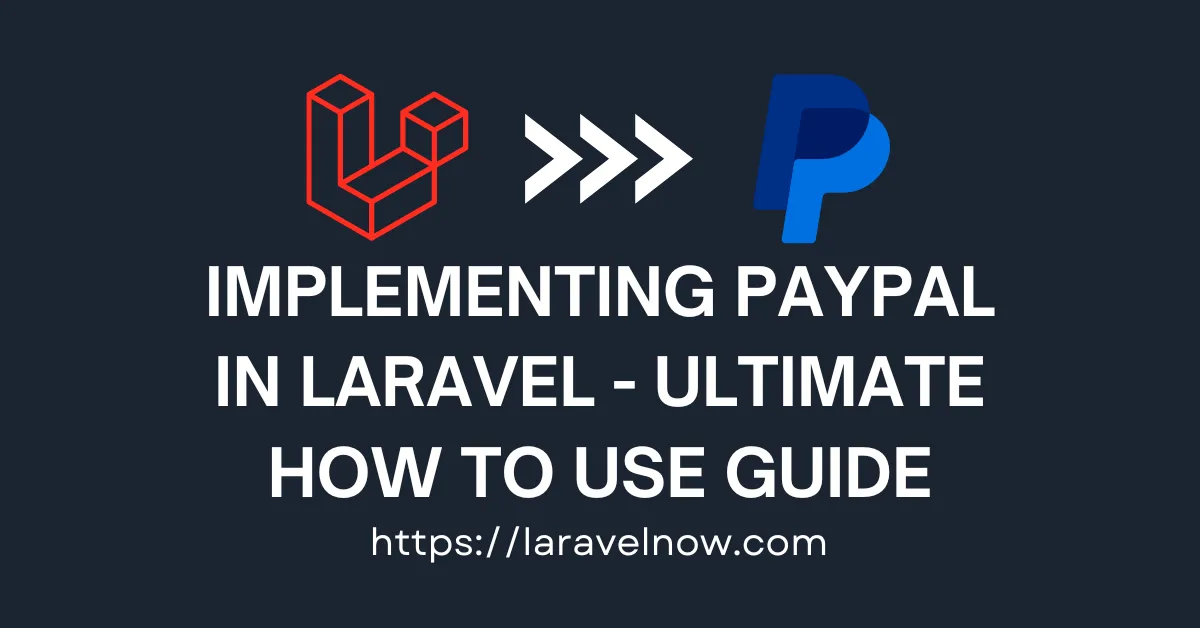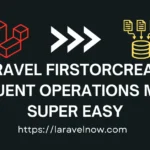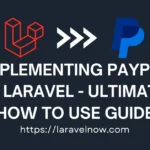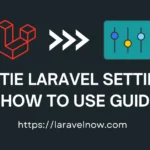Introduction:
In the fast-paced world of e-commerce, providing a seamless payment experience is paramount for retaining customers and driving revenue. One of the most trusted and widely-used payment gateways is PayPal. Integrating PayPal into your Laravel application can significantly enhance the checkout process and streamline transactions. In this detailed guide, we’ll walk you through the process of implementing PayPal integration in Laravel, complete with code snippets and best practices to ensure a smooth and secure payment experience for your users. For laravel paypal implement please follow the full tutorial.
Understanding Laravel and PayPal IMPLEMENT:
Laravel, as a powerful PHP framework, offers developers a robust platform for building scalable web applications. Integrating PayPal into a Laravel project involves leveraging Laravel’s features alongside PayPal’s RESTful API to securely process payments. This integration allows users to make purchases using PayPal, expanding your customer base and increasing conversion rates.
Setting Up Your Development Environment:
Before diving into the implementation process, it’s crucial to set up your development environment properly. Ensure you have Laravel installed, along with Composer, the PHP dependency manager. Additionally, create a PayPal developer account to access the necessary credentials and sandbox environment for testing purposes.
Installing Laravel Packages for laravel paypal implement:
Laravel simplifies integration tasks through the availability of various packages. Begin by installing the official PayPal SDK package using Composer. This package provides seamless interaction with PayPal’s API, making it easier to handle payment transactions within your Laravel application. Below is the Composer command to install the PayPal SDK package:
composer require "paypal/rest-api-sdk-php"Configuring PayPal Credentials:
After installing the PayPal SDK package, configure your PayPal credentials within your Laravel application. You can do this by adding the following lines to your Laravel application’s .env file:
PAYPAL_CLIENT_ID=your_client_id
PAYPAL_SECRET=your_secret_key
PAYPAL_MODE=sandboxReplace your_client_id and your_secret_key with your actual PayPal API credentials. Setting PAYPAL_MODE to sandbox enables testing in the PayPal sandbox environment. Remember to switch to live mode when deploying your application to a production environment.
Creating Buttons FOR Laravel and PayPal IMPLEMENT:
PayPal offers various types of buttons to facilitate different types of transactions, such as Buy Now, Add to Cart, and Subscribe. Below is an example of how to create a Buy Now button using PayPal’s Button Manager API:
use PayPal\Api\Button;
$button = new Button();
$button->setName('Sample Item')
->setType('button')
->setItemType('PRODUCT')
->setQuantity(1)
->setPrice('10.00')
->setCurrency('USD');
This code snippet creates a Buy Now button for a sample item priced at $10.00 USD. Customize the button parameters according to your specific product details and pricing.
Handling Payment Responses:
Once a user completes a payment transaction, PayPal sends a response containing important information such as the transaction ID and payment status. It’s essential to handle these responses within your Laravel application to update order statuses and provide feedback to users. Below is an example of how to handle a PayPal payment response
use PayPal\Api\Payment;
use PayPal\Api\PaymentExecution;
$paymentId = $_GET['paymentId'];
$payment = Payment::get($paymentId, $apiContext);
$execution = new PaymentExecution();
$execution->setPayerId($_GET['PayerID']);
$result = $payment->execute($execution, $apiContext);
if ($result->getState() === 'approved') {
// Payment successful
// Update order status and provide confirmation to the user
} else {
// Payment failed
// Handle error and notify the user
}In this code snippet, we retrieve the payment ID from the URL parameters and use it to fetch the payment details from PayPal. We then execute the payment using the payer ID obtained from the URL parameters. Finally, we check the payment state to determine whether it was approved or not, and handle the outcome accordingly.
Implementing IPN (Instant Payment Notification):
IPN serves as a crucial mechanism for receiving real-time notifications of payment events occurring within your PayPal account. To implement IPN in Laravel, you’ll need to create an IPN listener endpoint and configure it to receive and process IPN messages from PayPal. Below is an example of how to create an IPN listener endpoint in Laravel:
use Illuminate\Http\Request;
Route::post('/paypal/ipn', function(Request $request) {
// Validate IPN message
$ipnData = $request->all();
// Process IPN message
// Update order status and handle payment events
return response()->json(['success' => true]);
});In this code snippet, we define a route that listens for POST requests sent to /paypal/ipn. We then retrieve the IPN data from the request and process it accordingly. Remember to validate the IPN message to ensure its authenticity and integrity.
Managing Subscriptions IN LARAVEL PAYPAL IMPLEMENT:
For businesses offering subscription-based services, Laravel’s flexibility combined with PayPal’s recurring payments API enables seamless subscription management. Below is an example of how to create a subscription plan using PayPal’s RESTful API:
use PayPal\Api\Plan;
$plan = new Plan();
$plan->setName('Monthly Subscription')
->setDescription('Monthly subscription plan')
->setType('INFINITE')
->setPaymentDefinitions([
// Define payment definitions for the subscription plan
])
->setMerchantPreferences([
// Define merchant preferences for the subscription plan
]);
$createdPlan = $plan->create($apiContext);
// Retrieve plan ID and save it to your database
$planId = $createdPlan->getId();In this code snippet, we create a new subscription plan with a name and description. We then define payment definitions and merchant preferences for the plan. Once the plan is created, we retrieve its ID and save it to our database for future reference.
Enhancing Security Measures:
Security is paramount when dealing with sensitive payment information. Implement SSL/TLS encryption to secure data transmission between your application and PayPal servers. Additionally, adhere to PCI DSS compliance guidelines to safeguard against potential security threats and protect customer data. Below is an example of how to enforce HTTPS redirection in Laravel:
namespace App\Http\Middleware;
use Closure;
use Illuminate\Support\Facades\App;
class ForceHttps
{
public function handle($request, Closure $next)
{
if (!App::environment('local') && !$request->secure()) {
return redirect()->secure($request->getRequestUri());
}
return $next($request);
}
}In this code snippet, we define a middleware that checks if the request is not secure (i.e., not using HTTPS) and redirects it to the secure version of the URL.
Testing and Debugging:
Thorough testing is essential to ensure the seamless functionality of your PayPal integration. Utilize PayPal’s sandbox environment to simulate payment transactions and verify integration integrity. Implement logging and error handling mechanisms within your Laravel application to debug and troubleshoot any issues that may arise during testing. Below is an example of how to log messages in Laravel:
use Illuminate\Support\Facades\Log;
Log::info('Payment successful. Transaction ID: ' . $transactionId);In this code snippet, we log an informational message indicating that a payment was successful, along with the transaction ID.
Optimizing Performance:
Optimize your Laravel application’s performance to ensure efficient processing of payment transactions. Implement caching mechanisms to reduce database queries and enhance response times. Utilize Laravel’s queuing system to offload time-consuming tasks such as sending email notifications or updating order statuses, thereby improving overall application responsiveness. Below is an example of how to use Laravel’s caching system:
use Illuminate\Support\Facades\Cache;
// Store data in the cache for 60 minutes
Cache::put('key', 'value', 60);In this code snippet, we store a value in the cache with a specified key and expiration time.
Conclusion:
Integrating PayPal into your Laravel application opens up new possibilities for enhancing the payment experience for your users. By following the steps outlined in this guide and leveraging the provided code snippets, you can seamlessly integrate PayPal into your e-commerce platform and drive business growth. Embrace innovation, prioritize security, and deliver exceptional user experiences with Laravel PayPal integration. Elevate your e-commerce platform to new heights and stay ahead of the competition in today’s dynamic digital landscape.










